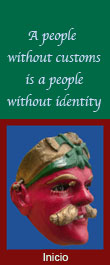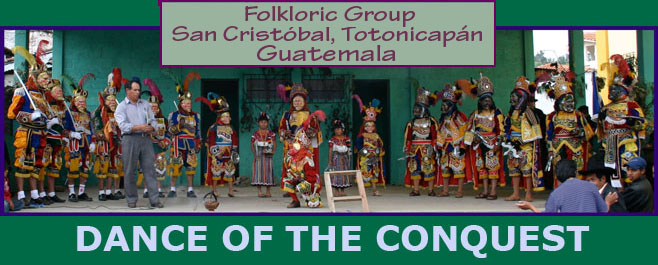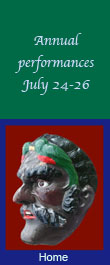Components of the Dance
Four modes of performance are integrated in the Baile de la Conquista. They are: music, dance, text, and pantomime.
1. Music
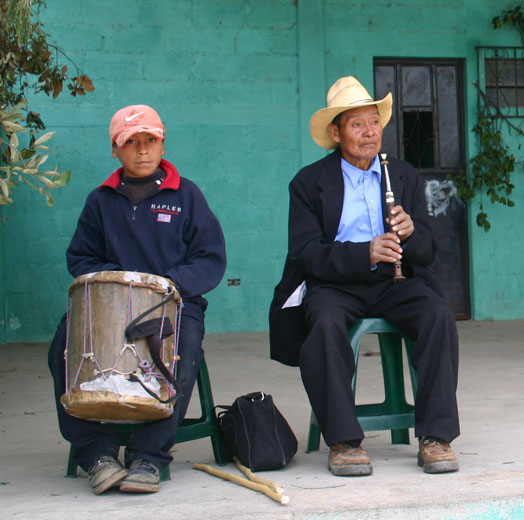 Instrumentation for the Dance of the Conquest combines the chirimía (shawm) for melody and tambor (parade drum) for rhythm. These were the popular dance instruments at the time the Dance of the Conquest was introduced in the late 16th or early 17th century.
Instrumentation for the Dance of the Conquest combines the chirimía (shawm) for melody and tambor (parade drum) for rhythm. These were the popular dance instruments at the time the Dance of the Conquest was introduced in the late 16th or early 17th century.
As the music for the dance developed, each adult character received his own tune or ‘son,’ and was given a dance with which to introduce himself, but most of these have fallout out of use. As transmission was oral, they have not been recorded in standard musical notation. They are disappearing in part because most active chirimía players are elderly and few youths choose to learn what is seen as an antique instrument.
 Today the sones for the Rey K’iche’, Tekum, and Ajitz remain the most popular, along with the march and the dance (balonia) of the Spanish soldiers. In contrast, the Malinches sing without musical accompaniment.
Today the sones for the Rey K’iche’, Tekum, and Ajitz remain the most popular, along with the march and the dance (balonia) of the Spanish soldiers. In contrast, the Malinches sing without musical accompaniment.
2. Dance
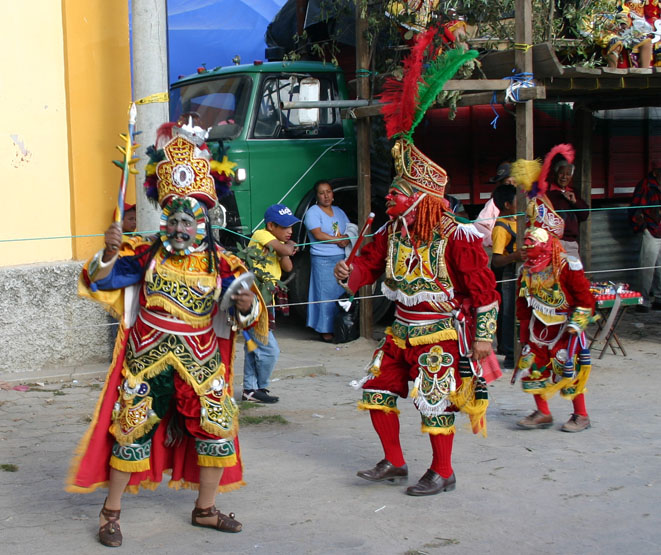 Each of the three parts of the drama is introduced by a dance. Other than these, dances and marches represent travel from one place to another.
Each of the three parts of the drama is introduced by a dance. Other than these, dances and marches represent travel from one place to another.
Such journeys usually involve two complete circuits of the dance field, with dancers alternately facing inwards and outwards. When dancers are traveling to one of the three raised platforms (Q’umarcaaj, Xelajuj Noj, and the temple) they approach this goal on its axis and depart in the same way. When any character is traveling, remaining Maya personages will often dance in place.
To the different groups also belong specific dance movements. At each of the four corners, pairs of Maya dancers circle around each other to mark the four directions. Spaniards often march or dance diagonally across the field as well. The Rey K’iche and his court generally form a lateral line as they dance their circuits and pivot at the corners. At the end of the drama, this line is expanded to include all of the performers. Ajitz and Chiquito follow the conventions for Maya dancers but also move more freely throughout the dance field.
3. Text
The musicians stop playing when text is declaimed. When a monologue is delivered by one of the three leaders (Rey K’iche’, Tekum, Alvarado), the speaker paces back and forth in front of the rest of his group.


The original text was likely written by a franciscan missionary in collaboration with K’iche’ caciques in the Valley of Los Altos. The text is written in the form of a three-act play following Spanish theatrical conventions but also constructing the drama as an heroic tragedy.
This text remained largely unchanged until the late 19th century, when additions were made by Maya authors in different communities, bringing out elements that were important to their communities at that time. The text used in San Cristobal includes a prologue and several additional or lengthened speeches that emphasize the heroic resistance of both Tekum and Ajitz.
4. Pantomime
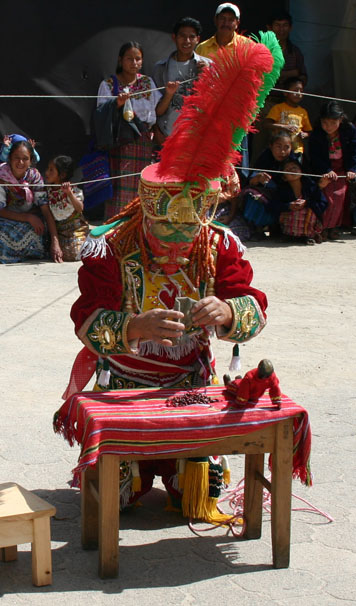 Pantomimed narratives take their cues from the text and are sometimes built around it, but may elaborate or depart from it. Some of these pantomimes require the use of special props like the divination table or the coffin for Tekum.
Pantomimed narratives take their cues from the text and are sometimes built around it, but may elaborate or depart from it. Some of these pantomimes require the use of special props like the divination table or the coffin for Tekum.
Extended pantomimes appear in the scenes with Ajitz and the Spanish ambassadors or emissaries in the second part, the battle in the third part, and the subsequent death and funeral of Tekum. The battle is the only pantomime that receives musical accompaniment, since it also involves dance-like choreography.
Use of pantomime has allowed Maya performers to elaborate aspects or introduce new meanings that the Spanish author did not consider, as well as to provide comic relief. The development of pantomime in this dance has allowed the role of Ajitz to become far more important than the Spanish author intended.
